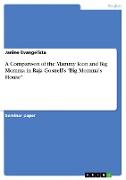- Start
- A Comparison of the Mammy Icon and Big Momma in Raja Gosnell's "Big Momma's House"
A Comparison of the Mammy Icon and Big Momma in Raja Gosnell's "Big Momma's House"
Angebote / Angebote:
Seminar paper from the year 2018 in the subject American Studies - Literature, grade: 1, 7, University of Lisbon, language: English, abstract: Since 19th century, African Americans have often been subjected to racism and marginalization within the American society. Although they have been brought as slaves to America several centuries ago and thus, probably live since generations in the country, they are barely recognized as members of the American community and are forced to live on the fringe of society. As a consequence, African Americans have become the targets of cinematic and television comedy, delineating various stereotypical images of African American men and women. David O. Selznick's film adaptation Gone With the Wind, published in 1939 and adapted from Margaret Mitchell's eponymous novel, offers the first portrayal of an African American woman. Conspicuously, the African American woman in the movie emphasizes stereotypical images being decisively devised by white American writers and film producers. Expeditiously, stigmatized ideas of African American women become coined under the imagination of Selznick's the 'Mammy'. Since the Mammy is defined as an obese, tall, and broad-shouldered woman, the majority of African American women in America clearly feel their stigmatization conforming the depiction of the Mammy by the white community, culminating in experiencing even greater social marginalization and rejection. Bearing in mind that the Civil Right Movements, where African Americans fought heavily for their personal rights and for an elimination of established stereotypes, occurred many years after the publication of Mitchell and Selznick's Gone With the Wind, readers and spectators are, nevertheless, confronted frequently with stigmatized images of African Americans. In 2000, Raja Gosnell published his comedy Big Momma's House, starring Martin Lawrence, representing not only drag performances, but also underlining anew the image of an overweight, broad-shouldered, and colossal African American lady. Martin Lawrence, acting as agent Malcolm Turner, dresses up as lady Hattie Mae Pierce, commonly known as Big Momma, by wearing a fat suit in order to proceed with his investigation. Consequently, similarities between the Mammy archetype and Big Momma in Gosnell's movie become rapidly obvious. Therefore, this research paper aims to answer the question whether Big Momma can be considered as a contemporary representation of the Mammy archetype or whether producer Raja Gosnell uses the Mammy stereotype in order to add extra comedic relief.
Folgt in ca. 10 Arbeitstagen
